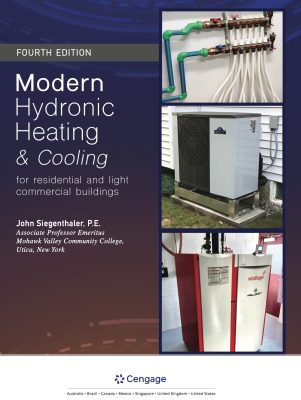Dual Load Dilemma

The Glitch
The Glitch
Overview: A contractor decides to set up a dual mod/con boiler system to supply high-capacity domestic water heating as well as several low-temperature space heating loads. Each boiler has a rated output of 200,000 Btu/hr. He chooses a series primary/secondary distribution system as shown below.Exercise: Can you identify at least four errors in this design?

The Fix
The Fix
For high-capacity domestic water heating, it’s essential not to create “bottlenecks” to flow or heat transfer. Instead, the circulator and piping for the indirect water heater should be able to convey the full output of the boiler plant while operating at a reasonable temperature drop.In this case that’s 400,000 Btu/hr. Assuming a nominal 20 ºF temperature drop across the heat exchanger in the tank, this requires a flow of 40 gem, far beyond the capacity limits of a 1/25 hp zone circulator and ¾-inch piping.
The relatively small internal coil in the indirect tank also creates a bottleneck to heat transfer. The tank can only accept a fraction of the heat output of the boiler system.
The solution shown is a high-capacity indirect with large internal heat exchanger. Large enough to dissipate the full output of both boilers without need for an inlet temperature above 180 ºF. The heat exchanger in the tank also needs to be piped for counterflow (hot water enters at top of coil). If a high capacity indirect is not available, an alternative solution is to use an external brazed plate heat exchanger.
The use of a series primary/secondary distribution system creates a temperature drop from one secondary circuit to another. Since the space heating loads are all low temperature, this will likely result in inadequate heat delivery to the downstream secondary circuits. The fix is to put those low temperature circuits in parallel. This is done with a header system coming off the hydraulic separator. The combination of generously sized “short & fat” headers along with the hydraulic separator provides the same hydraulic separation capability of primary/secondary piping without the need for a primary circulator.
Finally, the system supply temperature sensor for a multiple boiler controller should always be mounted downstream of the point that hydraulically separates the boiler plant from the distribution system. This ensures constant flow past the sensor regardless of which loads are operating.
Links
Looking for a reprint of this article?
From high-res PDFs to custom plaques, order your copy today!









